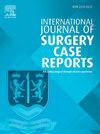Bedside management of a knotted Swan-Ganz catheter – A case report and literature review
IF 0.6
Q4 SURGERY
引用次数: 0
Abstract
Introduction and importance
Pulmonary artery catheters use remain invaluable in continuous invasive hemodynamic monitoring for patients with severe cardiopulmonary dysfunction and those undergoing major cardiac surgeries. It detects cardiac dysfunction and guides treatment decisions. Its utilization has declined due to common complications associated with its insertion. This article highlights a rare, rather an important complication of pulmonary artery catheter knotting and reviews techniques for its management. Prompt recognition of this rare complication by the clinicians allow immediate intervention minimizing morbidity and optimizing the outcomes. This manuscript follows the SCARE guidelines.
Case presentation
A case of a 61-year-old man who was initially admitted to the cardiothoracic unit for mitral valve replacement for symptomatic severe mitral regurgitation secondary to a bi-leaflet prolapse. Intra-operatively, a pulmonary artery catheter was inserted for invasive continuous hemodynamic monitoring. It was noted on a routine postoperative chest X-ray coiling of the pulmonary artery catheter in the right atrium. The catheter was not repositioned. On postoperative day one, significant resistance was encountered while removing the catheter. A chest x-ray was done and showed a knotted catheter in the superior vena cava. After contingency planning, bedside removal was opted as the preferred management approach. The catheter was carefully pulled out to tighten the knot and decrease its diameter, allowing successful extraction through the insertion site at the neck.
Clinical discussion
Pulmonary artery catheter utilization remains essential; however its insertion is prone to complications, which includes pulmonary artery catheter knotting a rare but an important complication that warrants immediate recognition and management. Numerous approaches for the management of knotted catheter were described in the literature. Bedside removal of the knotted catheter may be considered if the knot is simple and more proximal. This approach carries the risk of venous injury and hematoma formation, thus thorough planning and preparation are needed to avoid complications. An endovascular approach is opted in more complex cases and has largely supplanted surgical methods. Innovative methods were described in the literature and include the introduction of guide wires or specialized catheters to untangle knots under fluoroscopic guidance. Retrieval baskets may also be used. Surgery is reserved for complex cases, when endovascular attempts fail.
Conclusion
While pulmonary artery catheter use provides significant benefits, its use demands meticulous planning and preparation to avoid complications. Catheter knotting requires immediate attention. If bedside maneuvers fail, endovascular or surgical approaches may be necessary.
求助全文
约1分钟内获得全文
求助全文
来源期刊
CiteScore
1.10
自引率
0.00%
发文量
1116
审稿时长
46 days

 求助内容:
求助内容: 应助结果提醒方式:
应助结果提醒方式:


